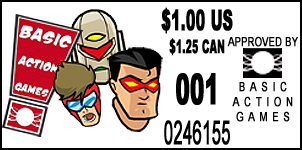We had our first game last night. The campaign is set in the Marvel Universe, but my two players do have their own original heroes. We're starting at 25 points but we're also using the Experience Point rules too.
The plot went thus: The Raft prison facility had lost power and they were trying to help SHIELD get things back under control. They had to get in and turn the power back on first of all. But on arrival at the main junction box they were met with Rhino who was trying to destroy said box.
We began combat, but quickly abandoned the constant rolling for Priority as it became quite tedious. So, with combat now underway, it kinda deteriorated into "You roll to hit, I roll to dodge, you roll damage, I roll soak. Now I roll to hit, you roll damage..." etc. There didn't seem to be much variation and tactics involved apart from the odd Called Shot to invoke an extra +10 Result damage.
The second fight later in the game was with the Living Laser. His tactics were more interesting (Blast them, then teleport away. They find him, so he creates a light illusion making 4 versions of hiimself... which is the real one! Dun dun duuuuun!) but the players once again just rolled basic to hit, rolled basic damage, rolled basic dodge and rolled basic soak. They did look quite bored by the end of it, sadly. I really want them to come back and carry on playing, but I'm not sure if it will happen.
I've just re-written there Heroes just to see how I would have made them, and by simply putting the Variable enhancement into their attacks, I've opened up about 10 different attack options.
Yet, without a simple purchase of Variable, everything seems quite stale.
Am I missing something? How do your games play out by comparison? What am I doing wrong??
Is there a way to temporarily boost your Defence? There don't appear to be any combat options such as sacrificing your action to Dodge, or Tripping people up (I ended up using the Knock Back rules to get people to change range or knock them down, but they just got back up and carried on blasting the following round).
Any and all advice is greatly appreciated, as I don't want to give up on this game... I have many plots I want to use!!






